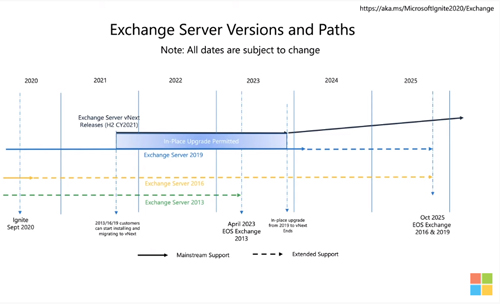News
Microsoft Shifting New Exchange, SharePoint, Skype and Project Server Products to Subscription Models in 2021
Microsoft announced last week in an Exchange Teams post and in at least one Ignite session that it will offer new application server products next year, but only via subscription-based licensing models.
The coming new subscription-based application server products, available in the second half of 2021, will include "Exchange Server, SharePoint Server, Skype for Business Server and Project Server." However, perpetual licensing will still be available on the Office software side. Microsoft is planning to offer "new perpetual-release" Microsoft Office products for both the Windows and Mac platforms "in the second half of 2021."
The announcement lacked details. Possibly, it described the end of days for customer premises-installed Microsoft application server software -- namely the end of Exchange Server, SharePoint Server, Skype for Business Server and Project Server.
Online Services Subscriptions
Subscription-based licensing is typically reserved for Microsoft's services software, which gets hosted by Microsoft on its own datacenter infrastructure. Exchange Online, SharePoint Online, Microsoft Teams and Project Online are all services where Microsoft controls the software installation, patching and software lifecycles.
Subscription-based licensing gets offered via monthly or annual payments. If it's not renewed, organizations can still access their data, but they can't modify it.
Microsoft's subscription-based services also typically follow the so-called Modern Policy lifecycle support model, instead of the more traditional Fixed Policy for customer premises-installed server products. The Fixed Policy offers 10 years of patch support divided into two five-year phases ("mainstream" and "extended"). The Modern Policy doesn't offer much in terms of lifecycle support assurances. At best, customers are promised an alert to major product changes 30 days in advance under the Modern Policy.
Further information about this switch wasn't provided. "We will share additional details around the official names, pricing and availability of all these products later," the announcement stated.
Exchange Migration Timeline
A Microsoft Ignite session, "Exchange -- Here, There and Everywhere," now available on demand here, didn't add much more to this picture. It suggested that Exchange Server users, from Exchange Server 2013 on up, should target their migrations toward Exchange Server 2019, which has much in common with the coming subscription-based Exchange offering, dubbed "vNext."
Users of older Exchange Server products, from Exchange Server 2013 on up, will be able to move to the VNext product via "in-place" upgrades. An in-place upgrade replaces the application server bits without IT pros having to move the data first and do "wipe-and-replace" types of installations.
The following timeline, showing Exchange Server product end-of-life dates, was shown during the Ignite session:
 [Click on image for larger view.] Exchange Server product end-of-life milestones. (Source: Microsoft Ignite 2020 session)
[Click on image for larger view.] Exchange Server product end-of-life milestones. (Source: Microsoft Ignite 2020 session)
During the Ignite talk, it was explained that Exchange Server 2019 only has two years of "extended support" (instead of the usual five years). The truncated extended support phase for Exchange Server 2019 was done intentionally by Microsoft to move organizations to its vNext subscription-based product, the talk explained.
Microsoft promised in another slide during this talk that "the new version [such as, Exchange Server vNext] will be built to support long term servicing, maintenance and easy upgrades." Further details weren't described, though.
Long-term servicing is not just a Fixed Policy option. It sometimes shows up as an option under the Modern Policy for some products, where it lasts, at most, for three years.
Other Exchange Perks
There was some good news last week for Exchange Server users. On the migration front, Microsoft's Hybrid Configuration Wizard now permits organizations to move their Exchange Server installations to multiple Exchange Online tenancies, if they have such things. Microsoft also relented from earlier related plans and is maintaining its Exchange Server Mailbox Role Calculator as a separately downloadable product.
Microsoft also is previewing a "cross-tenant mailbox migration" capability for Exchange Online moves. It removes some steps that were previously required.
"The new cross-tenant mailbox migration service eliminates the need to offboard and onboard the mailbox, resulting in a faster and lower-cost migration," the announcement explained. "This is particularly beneficial for organizations undergoing mergers, acquisitions, divestitures, or splits."
A new Exchange Admin Center portal is available (it was at preview back in July). Users get a more dashboard-like view of Exchange operations and e-mail activity with the new portal. Current portal users can switch to the new version via a toggle button that's located "in the top right corner."
Microsoft is also promoting use of the PowerShell version 2 Exchange Online module, which reached the "general availability" product-release stage last week. A big perk of this module is the ability to run scripts without depending on Basic Authentication, a simple password approach that Microsoft is deprecating in Exchange. Instead, the module features certificate-based authentication, which lets organizations enforce added security precautions, such as using multifactor authentication (a secondary identity verification method). The module also includes Linux and PowerShell Core support.
Microsoft also made "Plus Addressing" available worldwide for Exchange Online users. It's a sort of tracking tool that lets end users append a string of text to their e-mail addresses. If they share these appended e-mail addresses with various service providers that then give them to other parties, it'll be possible to see that disclosure and complain.
About the Author
Kurt Mackie is senior news producer for 1105 Media's Converge360 group.